In this post, I’d like to dissect what I like about my current GETTING THINGS DONE desk, how it makes me feel, how it helps flow/mind-like-water, and how somehow, it magically helps me get a ton of work done. See the previous Before/After post to get a fuller visual on my complete trusted system.
Desk 3.0 [*Note* Desk 4.0 has its own post and can be seen here]
OK, here is a picture of my 3rd generation GTD desk which includes the legs. The rest of this post is a discussion of the elements of the perfect GTD desk.
- Element #1: Clear desk surface
The longer I do GTD, the more I find that I need to spread paper out on the surface of my desk to organize it. I keep parallel project folders: in atoms making up manilla folders, and in bits in Omnifocus projects. I write one idea, one piece of paper into either atoms or bits, and I organize the pieces of paper on the surface of my desk. It is just invaluable for me to put my ideas across the desk surface and then ask myself what the individual ideas are trying to tell me.
In addition, a clear desk surface lets you take a nice butcher block sized piece of paper to mind-map when you are kicking off a natural project management event.
Requirements for a clear desk are:
- Get the monitor on an arm that clears your desk (I use the Innovative 7500-hd-1500 arm because I’m holding 24 and 27 pound iMacs up. I attempted to link to Amazon.com for this product but the links are not working, I bought my most recent arm from Seaboom.com as it was $65 to $110 cheaper than Amazon. The three models at SeaBoom do not have pictures, but I figured out their colors and have a guide herethat you can use to pick your color.).
- Consider switching to a 27″ all-in-one computer (Mac, PC), makes a clean desk easy
- If you can’t swing an all-in-one, think hard about why your brain is not worth having a high resolution 27″ in monitor (Mac, PC). Do you cut from one window and paste into another for a living? 27″ monitors double efficiency!
- Get a wireless mouse, and
- Wireless keyboard (Mac, PC) so you can move keyboard and mouse off the desk and using the surface for your brain’s organizing pleasure.
- Resurface the desk, early and often. I’ve had original veneer, maple veneer, and currently, a $45 sheet of Formica (works great as a whiteboard!) on the surface of my desk. On my too-dark, too-depressing desk at home, I’ve resurfaced with whiteboard contact paper. Amazon has a veritable zoo of contact papers (easy on, easy off if you don’t like them) which allow your brain to employ whimsy to please itself as you work. Experiment and enjoy!
I look forward to the day when I can remove the telephone from my desk! I currently do about 90% of my phone calling with Skype and a wireless headset. I’ve thought about suspending the computer from the ceiling or from a cart that can be driven away from the desk to leave the desk space 100% analogue, but these are not currently practical given all the cables that have to be run.
- Element #2: Big desk surface
The best data I’ve seen on the surface area needed for information workers comes from Demarco and Lister’s book Peopleware.
Before drawing the plans for its new Santa Teresa facility, IBM violated all industry standards by carefully studying the work habits of those who would occupy the space. The study was designed by the architect Gerald McCue with the assistance of IBM area managers. Researchers observed the work processes in action in current workspaces and in mock-ups of proposed workspaces. They watched programmers, engineers, quality control workers, and managers go about their normal activities. From their studies, they concluded that a minimum accommodation for the mix of people slated to occupy the new space would be the following: 100 square feet of dedicated space per worker 30 square feet of work surface per person
DeMarco, Tom; Lister, Timothy R. (2010-04-15). Peopleware: Productive Projects and Teams (Kindle Locations 812-818). Dorset House Publishing. Kindle Edition.
30 square feet of work surface is H-U-G-E. My desk is 34″ deep, so to have 30 square feet of work area, my desk would need to be 10.5′ long! As my desk is merely 6′ long, I’m coming up short with a 17 square foot desk. I forecast that GTD will be adding some desk space to my office before too long. But for now, I’m squeaking by with a single work surface and living 13 square feet below my potential. :-)
Another interesting aside is how many of my students are trying to live on tiny desks. Here’s Paulina Menchaka’s before and after desks (Paulina has kindly granted me permission to share these pictures). See if these pictures feel the same or different when you think about sitting down to work at these desks?
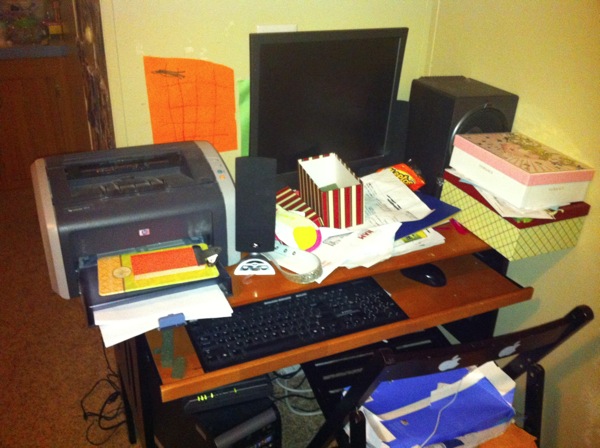
Here is what my desk looks like today. The mouse and keyboard can be moved out of the way, and the monitor can be pushed back to free up desk surface.
Summary, you need elbow room to think. You need to work with your entire brain, that means spreading things out in front of it, moving things around, giving the brain time to compost, and then listening as your subconscious bubbles up ideas. No substitute for lots of work surface and unrestricted access to that surface.
- Element #3: Slide-to-side room
I think it is required that you have the ability to roll your chair to slide sideways across your desk. This is required first, because it gives you a sense of freedom not having your knees crowded from both sides (John Niebergall, you know who you are!). Second, as projects are underway, new projects have a way of finding their way on to your desk. With a clear surface and sideways sliding room, you can be practically opportunistic in sliding sideways and setting up a 2nd (and sometimes a 3rd) project that you have to run in parallel with your starting project. I just get a sense of release when I look at a desk that is flexible allowing side to side sitting. Open-ness side to side also lets you invite people to work beside you at your desk. For example, I often have my students put their laptops on the right hand end of my desk so they can step through an Excel exercise on their own computer as I step through it on my computer.
- Element #4: Conference table legs
My desk was part of a very business-like Jesper office set I bought in Boise in 2002. I’ve been refining the desk ever since.
When, in January 2011, I was trying to fit the desk and its side skirt supports into my office a Concordia, I realized that there just were not enough degrees of freedom with side skirt legs. For example, you can’t really have a meeting with someone across a desk that has skirts like this. What I really wanted was a conference table. Once I realized this, I went to IKEA, and bought a Galant leg set and table frame (IKEA part number 101.501.69 I can’t find it on their web site) for $80 and make my modified Jesper desk into the conference table style desk.
- Element #5: Cable management
The more I do GTD, the simpler I need my desk to be. It takes a lot of complexity to make a desk appear simple and purely functional. Note that I have 2 cable management systems under my desk. The white box attached to the left two legs is a $10 IKEA cable management solution that confines power strips and extra lengths of cable beautifully. I don’t care how messy the cables are as long as I can’t see and don’t think about them. In addition to the cable management system I have a Trip-Lite 12 outlet strip attached underneath the work surface.
Geek readers will detect an external USB hard drive on the top of the cable management unit. In 2011 I decided to squeeze another 2 years out of my 2008 iMac by replacing the boot disk with a solid state drive and moving the home folder to external USB drive. Amazing speedup!
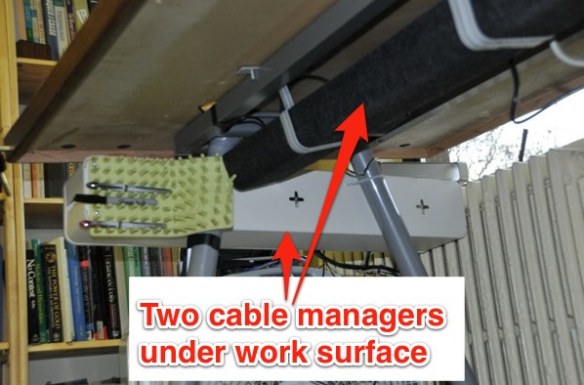
The second cable management system is perpendicular to the white box, and consists of the dark felt trays with the light brackets holding them to the underside of the work surface. IKEA has apparently killed both these cable management systems, but fortunately, they have introduced new systems as well. So, for $40 you can have all the under-work surface cable management you need.
Cable management above the work surface is a matter of twist ties, cable ties, double-sided-sticky-tape, and corrugated finger-pinching tube. Here is the behind the scenes cable management story of my desk. Since this picture was taken, I’ve drilled a 3″ hole at the base of the monitor arm so I could route all the cables directly through the desk to the cable management trays beneath it. Here is the right hand side of the monitor arm: Note my pen and trusty 3″x5″ cards at the ready behind the iMac monitor.
Red arrows show tools behind the monitor, yellow arrows in the following two pictures show the extensive re/use of double sided sticky tape in desk enginerding.
On the left hand side of the monitor arm you can see two Bose speakers, a 7 port USB hub, a 5 port ethernet switch, and an $11 fluorescent light, all attached with double sided sticky tape. All this is a mess, but I don’t care, since I can’t see the mess. Out of sight means no open loop for my mind.
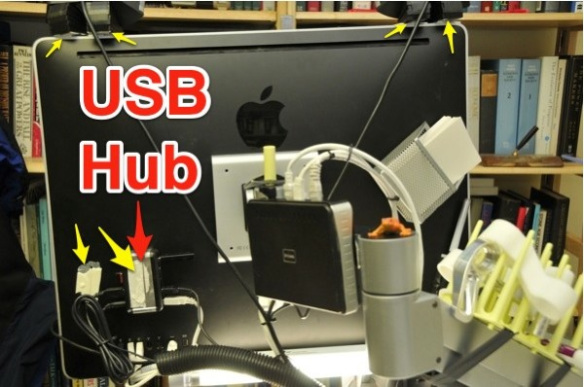
Note the white plastic objects in the yellow file folder fingers on the diagonal part of the monitor arm. These are 3D printed objects that I need to have readily available. They are clutter unless I need them, so I keep them behind my iMac screen. I don’t see them and so am not bothered by them while I’m working.
- Element #6: Killer Cool Paper Trays
The current state of GTD paper tray technology is deplorable! Even before I discovered GTD, I conducted a frustrated search of the internet to find something that was not boring, something I called “goofy.” What I found was a multiple tray system designed by Shaunn Fynn and sold by Custom Plastics Inc of Elk Grove Village, Il. I think that Custom Plastics has given up on selling this multiple paper tray. You can still find a very similar desk organization system at high end wood product components manufacturers like Doug Mockett but the series is being discontinued. No matter. I think the requirement is for some element of whimsy in your paper trays. By whimsy, I think that GTDers need to go beyond tidy. We need a dash of not-too-over-organized-and-fun, on our desks without introducing clutter. Shaun Fynn’s elevated multiple trays, are a perfect entry point a fresh breath of creative desk whimsy!
Story: When I moved to Concordia University last January, I took my original paper tray system that looked like the 3 tray system in the right of this picture:
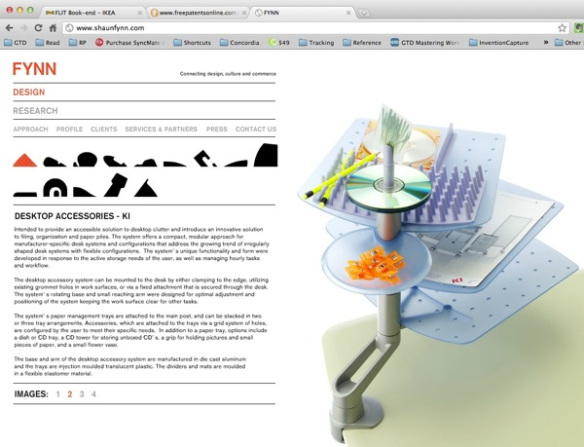
And then I blatantly sucked up to the awesome physical plant team at CU, and they removed the base of the tray system, and then J-B Welded the paper tray base to the base of my monitor arm. These paper trays are fun because they can rotate around the axis of the vertical post. You can line them up one above the other if you are felling left brained, or you can align them asymmetrically if that is what pleases your muse.
I use the top tray for my inbox (please note that since having a week to work undisturbed in my office I’m at INBOX ZERO!), the second tray has my natural project management form (I turned GTD chapter 3’s natural project management process, into a 1 page form. See Appendix A at the end of this post if you want a copy), and the bottom tray has blank white letter sized paper.
I started doing GTD in March 2009 (after meeting Ian Watson at COMDEX 2009 at the end of January). It took Ian a month to get me to promise to read GTD. The time since then has been a roller coaster journey of increased productivity, decreased stress, then increased stress, decreased productivity. In the process I’ve refined, refactored, rethought, and redesigned my desk. When I sit down now at my desk, I feel pleasure at being able to work. This is true at my office desk and at my home desk (BTW, stay tuned for a blog post on an upgrade to the home desk in January 2012).
I have learned, that if I am feeling pressure from work that there are two causes:
- First, I have not done my review. I don’t think weekly is enough for me to get current on everything. But daily is too often. I have an annoying meat brain and continue to search for the sweet spot of my meat spot. :-)
- Second, I am not organized enough.
My desk is a key component of my trusted system. Desk is the place where I work on atoms and bits of my next actions. As I’ve sharpened my desk, my physical filing, electronic filing (Evernote for documents + Kindle for ebooks), I’m becoming more productive and less stressed. I see this working for my students as well. I think it can work for you if you have that knot of doubt in your stomach about whether you can ever hear someone say “Your desk is awesome!” (My wife Beth said this 2 days ago about my 2nd-string home office desk, and it made my week!). If I can implement GTD, anyone can (check out the before/after pics here if you haven’t seen them: http://restartgtd.com/2011/12/29/gtd-journey-after/).
For now, my theory of the perfect GTD desk is to bring together 6 elements (However, I reserve the right to add more elements if needed!):
- Clear desk surface
- Big (ideally 30 square feet)
- Slide to side (open front)
- Conference table legs
- Cable management
- Killer cool paper trays
In addition to my work desk, I have used GTD to redesign my wallet into a pico-desk, my BookBook laptop computer case as a nano-desk, and my Kensington rolling briefcase into a mobile desk. More on these in later posts.
- Appendix A: Meade’s Natural Project Management 1-Page Form
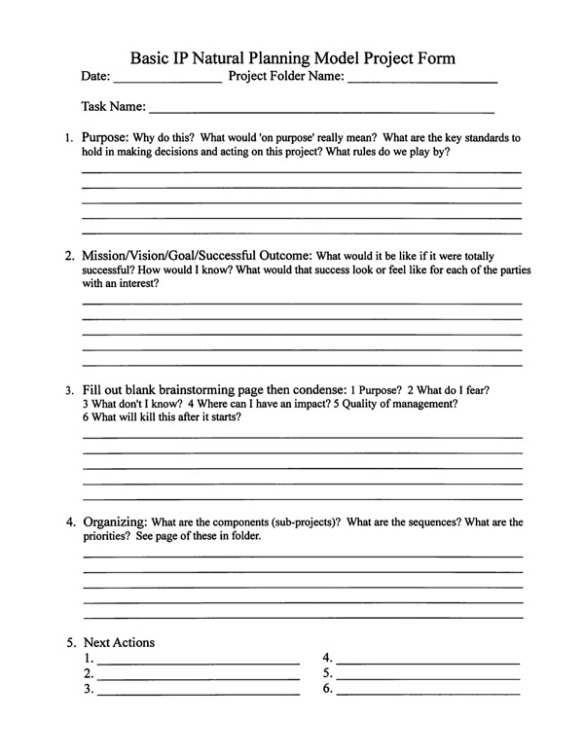
Support RestartGTD by buying at Amazon with this link!

Pingback: Quick Index of Most Read Posts | RestartGTD
This website was… how do I say it? Relevant!! Finally I’ve found something that helped me.
Kudos!
Pingback: Number 1 Reason GTDers Don’t Use Evernote … after installing Evernote | RestartGTD
Pingback: Just Do The Worm | RestartGTD
Pingback: Ask LH: What Can I Do When I Run Out Of Space On My Desk? | Lifehacker Australia
Pingback: What Can I Do When I Run Out of Space on My Desk?
Pingback: What Can I Do When I Run Out of Space on My Desk? « Music RSS
Pingback: Escalate Digital Media | What Can I Do When I Run Out of Space on My Desk?
Pingback: What Can I Do When I Run Out of Space on My Desk? « bogdi dot com
Do you mind if I quote a couple of your articles as long as I provide credit and sources back to your site?
My website is in the very same niche as yours and my visitors would definitely benefit from some of the
information you provide here. Please let me know if this ok with you.
Thanks!
ZG!
To you and anyone else who is interested, I’m DELIGHTED to have any of my writings (restartgtd.com and basicip.com as well) quoted with attribution. Go for it!
And, please email me and let me know what you are working on. Writing a GTD blog is lonely and fellowship is welcome!
bill meade
Pingback: Notice in: Looking for work | RestartGTD
Pingback: All Things of World
Pingback: Perfect GTD desk +1 | RestartGTD
Pingback: Musings on eighth grade organizing … | RestartGTD
Hello Bill, I’d like to use your photo of the “perfect GTD desktop” (the first one in this entry) to be used in an article I’m writing for a spanish electronic magazine for TIC teachers. Obviously I’d add a link to this blog entry . Could you tell me if you have licensed it some way or emailing me an authorization to be used with such purpose.
This is the magazine http://recursostic.educacion.es/observatorio/web/es/home (It’s hosted by the spanish ministry of education). All its contents are under this CC license: http://creativecommons.org/licenses/by-nc-sa/2.0/deed.en
Thanks in advance
The Monitor arm on in the article is super expensive.
I found much cheaper one here for the average joe lol
http://www.monoprice.com/products/search.asp?keyword=monitor+arm&x=0&y=0
I bought two wall mounts so far from their site and they are just as good as expensive ones.
Thought people should know there are much more affordable options
Yeah, I know it is expensive. But, because I’m throwing 27.6 pound iMacs up on these arms, I have to have a heavier duty model. Kensington has a reasonably priced model ($118) but alas, it is limited to 20 pounds. :-(
Also, because I mount my paper trays on the base of the monitor arm, I need a post that I can work from.
I really like the $39 model on the site you recommended! It has a post for paper trays, although I’d need to reengineer my design.
Thanks Sylar for the pointer. It is going into my GTD evernote notebook!
[email protected]
Pingback: Minimalism
Which bose speakers do you use? And how are they powered? Thanks for the great post.
Bose Companion 5s. They are not only awesome, they fit into the over-all GTD desk very well. Perching the speakers on the top of the iMac keeps them off the desk (thus preserving a clear work surface). Here is a detailed pic:
iMac Bose Companion 5 Setup
That angle of the speakers is generated with black plastic shims from Home Depot. I think I used 6 of these shims, wrapped them together with electrical tape, and then double sided sticky taped 2 sets of shims to each speaker (speakers are hefty), and then double sided sticky taped the bottom of the shims to the iMac. I had to be careful to balance the speakers so they would not tip back or forward. This terrible mounting hack, has worked for 2 years. So I pronounce it “good enough”. :-)
I prefer having the speakers on the iMac because when I’m in the “sweet spot” between the speakers, the sound is detailed and rich, but it is not loud, so I preempt the people in offices around me complaining. I have not yet had a complaint. If the speakers were on the walls or book-cases, the sweet spot would not be as righteous as it is when you are 3 feet from the drivers.
Another bonus I get from the Companion 5s is that the subwoofer sits under my desk and is a perfect foot rest so that I can recline my chair to the optimal 135 degrees (thank you Kevin Frapin).
Bose Companion 5 speakers are powered by a wall cord to the sub-woofer. You use USB to connect the sub-woofer to the computer. On a Mac you need to go into /Utilities/Audio Midi Setup to designate the stereo or quadraphonic, or surround 5.1 mode that the speakers enact.
[email protected]
Really nice desk. I appreciate you going through and writing about why you picked the things you did. Mounting a bunch of stuff on the arm of the monitor mount is a great idea. I am looking forward to reading about how you will transform your wallet, laptop case, and rolling brief cases. One suggestion: I started to carry around a Space Pen bullet and have really enjoyed it. I don’t always have a shirt with a pocket to have a pen at all times, but that Space Pen has been great.
Is this the pen you are recommending?
http://www.amazon.com/gp/product/B000095K9D/ref=as_li_ss_tl?ie=UTF8&tag=noflaming&linkCode=as2&camp=1789&creative=390957&creativeASIN=B000095K9D
My thoughts are that if I get a smaller pen than the Uniball Elite pens I’m using now:
http://www.amazon.com/gp/product/B00006IE9J/ref=as_li_ss_tl?ie=UTF8&tag=noflaming&linkCode=as2&camp=1789&creative=390957&creativeASIN=B00006IE9
I’m afraid I’ll have to get another passport wallet because my 3″x5″ cards will fall out. I suppose I could just double the number of cards in the wallet though.
Great suggestion! Thank you for sharing!!! Questions:
How do you carry the pen, pants pocket?
What is the one best thing about the Space Pen bullet?
[email protected]
#inspired! Stumbled onto your page here and have a trip to ikea planned for your conference table. I desperately need to reconfigure my work surface, and this may be just the ticket. Thanks very much for the example.
More important than the size of the work surface, is the usability of the work surface. Because I put so much equipment on the back of my monitors and all-in-one computers, I buy heavy duty monitor arms but I also persuade a lot of people buy the Ergotron lightweight monitor arms. Please, please, trust me that you will never regret getting your monitor off your desk. Also, get a small wireless keyboard and small mouse and then get in the habit of putting them off the desk at night so the desk open-ness can surround you as much as possible.
I just found your site thanks to David Allen tweeting about you. So glad he did! I am thinking of building my own table this week to incorporate a lot of this. If I do, I’ll be sure and send a pic of before and after.
I’m working on a home desk upgrade in the next couple of months. What I’ve done is to buy an IKEA conference table and then bought a second monitor arm: the Innovative 7500-hd-1500 monitor arm ($263 at Amazon and $200 at SeaBoom.com).
What this approach gets me is more desk work square feet that are uncluttered. I’m 17 feet short of the 30 square feet recommended in Demarco and Lister’s PEOPLEWARE book. The conference table gets me 10 more square feet. I almost feel like I’m taking a table out of an Apple store and putting it in my office at home. But, for once, I have the square feet of office space to do this as my 5,000 volume library is at my Concordia University office.
Enjoy your blog & pics! In envy anyone who has option for a dedicated office - at work or at home. But I do seek the elements you describe in my portable work process … library tables, corners, dining room tables, slide to side on old door propped by saw horses, cables bundled & re bundled. I think we each have internal worksite preferences.
Pingback: Mount Stuff on the Back of Your Monitor for a Clutter-Free Desk [Workspace] | That Soviet Guy
Best tip here is the power of a clear desk surface for clear, innovative thinking. Also love the planning form at the end. Thanks!
I agree about clear desks having power. Magic pixie dust power. I began to learn about this when I was helping an emergency room (ED) doctor implement GTD. He was hitting glass ceilings and walls. On a road trip to home depot in his most excellent 1976 pickup truck, I said “Tell me about your office?” He scowled and gripped the steering wheel tighter and said “I don’t like my office.” This was an interesting thing for him to say given that he lived in a custom designed house, with a custom designed office. I said “Why?” and he was silent and then said “Clutter”. Clutter is the strategic enemy. I must needs post a few clutter stories. But in short, when I did a makeover of his desk, I found that he had clutter organizers on it, and pictures of kids, and teddy bears in blue bows etc. as his spouse had been working hard to help him by making his work environment rich with family mementos and memory pictures. Instinctively I nuked his desk, got everything off it, pushed his file organizers to his left where they were not in his line of sight when working. *Poof* magic. Well, almost magic, I made him buy a monitor arm, wireless keyboard, blah blah blah see the perfect GTD desk post above. But, suffice to say, this is the kind of experience that led me to push the envelope on clear desks. Thanks for your comment!!!!
[email protected]
The PDF of the natural project planning form should be available on my twitter feed (billmeade) and on facebook. Also, I’m attempting to share the pdf here via Evernote:
http://www.evernote.com/shard/s3/sh/38c71854-c583-4376-bda9-4ae20f5c77f4/91d5c1e321c2a8cf6ab32406f7ab1cdf
email me ([email protected]) if you would like a custom emailed copy.
Pingback: Mount Stuff on the Back of Your Monitor for a Clutter-Free Desk | Got2.Me
Some great ideas, I like the USB hub and the SSD to boot with. Getting a clear desk would be helpful at my school, but probably just about impossible.
I’m working with local high school teachers in Portland Oregon on GTD. They are some of my “visual learners” who despair of ever getting a clear desk. We are not far from having the first clear desk transofrmations (look for “abomination of deskolation” in the restartgtd.com blog posts.
You can do it. You just have to get out of the cul-de-sacs preventing progress!
bill meade
Pingback: Mount Stuff on the Back of Your Monitor for a Clutter-Free Desk [Workspace] « Go Digital Apps
Pingback: Mount Stuff On The Back Of Your Monitor For A Clutter-Free Desk | Lifehacker Australia
Thanks for the article! Where did you get the $11 fluorescent light?
WalMart! Home improvements.
bill meade
An amazon product that looks exactly the same is the GE 10167 Slimline Fluorescent 8″ $16 Light Fixture:
http://www.amazon.com/gp/product/B001ET6D8E/ref=as_li_ss_tl?ie=UTF8&tag=noflaming&linkCode=as2&camp=1789&creative=390957&creativeASIN=B001ET6D8E
Amazon also has an 18 inch model for $15:
http://www.amazon.com/gp/product/B000HJ75PW/ref=as_li_ss_tl?ie=UTF8&tag=noflaming&linkCode=as2&camp=1789&creative=390957&creativeASIN=B000HJ75PW
Thanks! I also found a 23″ version at Amazon for $23 (http://www.amazon.com/dp/B001ET6D8Y) but perhaps that’s too big for my 23″ monitor.
For implementing GTD you can use this this application:
http://www.Gtdagenda.com
You can use it to manage your goals, projects and tasks, set next actions and contexts, use checklists, and a calendar.
Syncs with Evernote and Google Calendar, and also comes with mobile version, and Android and iPhone apps.
Ok, called out and ready. How about my sweet desk 2 right wall and a new 10′ desl under the window?
John! Send me before and after pictures!!! [email protected]